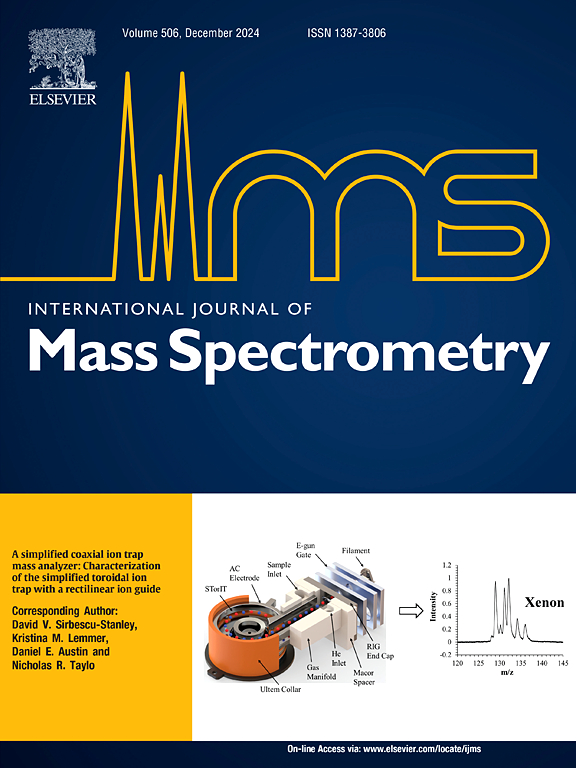电喷雾离子化质谱中异苯二甲酰胺与磷酸化生物分子的络合反应
IF 1.7
3区 化学
Q3 PHYSICS, ATOMIC, MOLECULAR & CHEMICAL
引用次数: 0
摘要
电喷雾离子化(ESI)可将生物大分子从溶液温和地转移到真空中,有助于在高度受控的条件下研究生物分子结构。然而,生物大分子在电喷雾离子化过程中会脱溶,与溶剂分子失去离子氢键会导致结构重排,其中最突出的是暴露在溶剂中的电荷位点。微溶解试剂可以在 ESI 质谱分析(ESI-MS)实验中与这些裸露的电荷位点结合,提供替代的分子间相互作用伙伴。此前,18-crown-6 已被证明是与阳离子单烷基铵残基结合的有效试剂。最近,有报道称异酞胺二乙醇(DIP)是一种类似的阴离子微溶胶试剂,主要用于小型模型肽的羧酸残基。在此,我们将进一步研究 DIP、1,1'-(1,2-亚苯基)双(3-苯基脲) (PBP) 和三氯卡班 (TCC) 与具有末端或连接磷酸盐分子的复合物。具体来说,我们使用 ESI-MS 评估了这些试剂与磷酸二甲酯 (DMP)、环磷酸腺苷 (cAMP)、二丁酰基 cAMP、RNA 二核苷酸 ApU 和 CpG 以及血管紧张素 II 磷酸酯 (DRVpYIHPF) 的结合情况。对于最小的目标分子 DMP,试剂 TCC、PBP 和 DIP 显示出良好的吸附效果。然而,对于较大的系统,PBP 和 TCC 的络合作用有所降低,原因是 PBP 的末端芳香分子和 TCC 的有限氢键网络产生了立体阻碍。总之,在这三种试剂中,DIP 在磷酸基团的阴离子微溶胶化方面表现最为稳定,有助于今后对气相生物分子结构和微溶胶化效应的研究。本文章由计算机程序翻译,如有差异,请以英文原文为准。

Complexation of diserinol isophthalamide with phosphorylated biomolecules in electrospray ionization mass spectrometry
Electrospray ionization (ESI) enables gentle transfer of biomolecules from solution to vacuum, facilitating the study of biomolecular structure under highly controlled conditions. However, biomolecules are desolvated during the ESI process, and the loss of ionic hydrogen bonds to solvent molecules can drive structural rearrangement, most prominently at solvent-exposed charge sites. Microsolvation reagents can bind to these bare charge sites in ESI mass spectrometry (ESI–MS) experiments, providing alternative intermolecular interaction partners. Previously, 18-crown-6 was shown to be an effective reagent for binding to cationic monoalkylammonium residues. More recently, diserinol isophthalamide (DIP) was reported as an analogous anionic microsolvation reagent, primarily for carboxylate residues of small model peptides. Herein, we expand upon this work to examine the complexation of DIP, 1,1’-(1,2-phenylene)bis(3-phenylurea) (PBP), and triclocarban (TCC) with molecules featuring a terminal or linking phosphate moiety. Specifically, using ESI–MS, we assess the binding of these reagents with dimethyl phosphate (DMP), cyclic adenosine monophosphate (cAMP), dibutyryl cAMP, RNA dinucleotides ApU and CpG, and angiotensin II phosphate (DRVpYIHPF). For DMP, the smallest target molecule, reagents TCC, PBP and DIP showed favorable adduction. However, for larger systems, PBP and TCC showed reduced complexation, which was attributed to steric hindrance from the terminal aromatic moieties of PBP and the limited hydrogen bonding network of TCC. Overall, of the three reagents, DIP showed the most consistent performance for anionic microsolvation of phosphate groups, facilitating future studies of gas-phase biomolecular structure and the effects of microsolvation.
求助全文
通过发布文献求助,成功后即可免费获取论文全文。
去求助
来源期刊
CiteScore
3.60
自引率
5.60%
发文量
145
审稿时长
71 days
期刊介绍:
The journal invites papers that advance the field of mass spectrometry by exploring fundamental aspects of ion processes using both the experimental and theoretical approaches, developing new instrumentation and experimental strategies for chemical analysis using mass spectrometry, developing new computational strategies for data interpretation and integration, reporting new applications of mass spectrometry and hyphenated techniques in biology, chemistry, geology, and physics.
Papers, in which standard mass spectrometry techniques are used for analysis will not be considered.
IJMS publishes full-length articles, short communications, reviews, and feature articles including young scientist features.

 求助内容:
求助内容: 应助结果提醒方式:
应助结果提醒方式:


